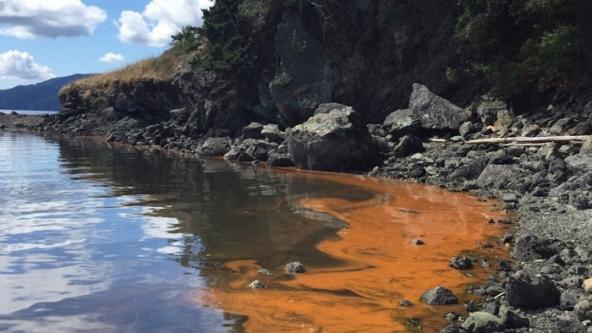Harmful algal blooms in the Salish Sea
Formerly known as “Red Tide”, harmful algal blooms are a health concern for both wildlife and humans. The following is a brief review of some of these algae and their effects.
Harmful algal blooms (HABs) occur when hazardous phytoplankton or other algae quickly grow and accumulate in a particular aquatic location. Often, biotoxins from HABs move through the food chain when they are concentrated in filter-feeding bivalves or consumed by planktivorous fish. These prey are readily ingested by marine mammals, birds and humans. As a result, significant animal die-offs or food-borne human illnesses are commonly associated with these events. The Washington Department of Health’s Office of Shellfish Safety and Water Protection monitors biotoxin levels within shellfish and decides when harvest areas must be closed due to health concerns. In addition, the SoundToxins partnership provides weekly monitoring of phytoplankton, including HAB species.
Because not all algal blooms are dangerous, merely noting the presence of algae, including the use of satellite remote sensing of chlorophyll, is not sufficient to determine a threat. Spatial and temporal trends are difficult to track due to the complexity of the environmental and ecological factors that influence HABs. Scientists have observed that HABs appear to be increasing in frequency and magnitude over the past half-century, possibly due to anthropogenic changes in global climate or aquatic environments. HABs were once known as 'Red Tide', but not all HABs are red. The following list includes HABs that are of special concern within the Salish Sea region.
HABs known to occur in the Salish Sea
- Akashiwo sanguinea – Dinoflagellate. Breaks down into foamy surfactant that coats seabirds’ plumage and impedes their waterproofing capacity, causing hypothermia, hypoglycemia and death if not rehabilitated appropriately. Source of multiple widespread seabird die-offs.
- Alexandrium spp. – Dinoflagellate. Produces saxitoxin, which interferes with neural impulses and causes myriad clinical signs and death in mammals and birds. Called Paralytic Shellfish Poisoning in humans, symptoms include nausea, vomiting, oral numbness and muscle paralysis. Death occurs via cardio-respiratory arrest. Toxicity is not mitigated by cooking. There is no known antidote.
- Dinophysis spp. - Dinoflagellate. Produces okadaic acid and dinophysistoxins, which cause nausea, abdominal pain, vomiting, diarrhea, headache, chills, and fever in people who eat shellfish contaminated with the toxin. The syndrome in humans is called Diarrhetic Shellfish Poisoning (DSP). A cluster of human illnesses was caused by mussels contaminated with these toxins in Washington State and nearby British Columbia, Canada, in 2011. Not mitigated by cooking. No known antidote.
- Heterosigma akashiwo – Raphidophyte. Golden brown in color. Lethal to fish via disruption of gill function and subsequent respiratory failure. Toxic mechanism is uncertain: may include neurotoxin, superoxide radicals, or physical gill damage. Significant issue for wild and commercial fisheries. Not known to cause human illness.
- Microcystis and Anabaena spp. – Cyanobacteria. Historically found in freshwater habitats but has spread to marine areas. These cyanobacteria produce the toxins, microcystins, which cause gastrointestinal distress, liver failure and death. Microcystins originate in lakes and streams adjacent to the Salish Sea, but concentrations of these toxins have been measured in marine waters of Washington State.
- Pseudo-nitzschia spp. – Diatom. Produces domoic acid, which causes acute and chronic neural disorders in marine mammals and birds (well-investigated in California sea lions). Called Amnesic Shellfish Poisoning in humans: the most notable symptom is short-term memory loss. Can be lethal. Not mitigated by cooking. No known antidote.
- Ulvoids – Seaweed. No evidence of biotoxin production. In certain conditions, can outcompete other organisms for sunlight, nutrients and other resources, thus altering ecosystems.
HABs not known to occur in the Salish Sea
- Karenia brevis – Dinoflagellate. Blooms found off the Atlantic coast of the southeastern US. Produces brevetoxins that disrupt the nervous system and can cause death in many marine species. Called Neurotoxic Shellfish Poisoning in humans.
- Pyrodinium bahamense & Gymnodinium catenatum – Produce saxitoxins (see Alexandrium spp.).






